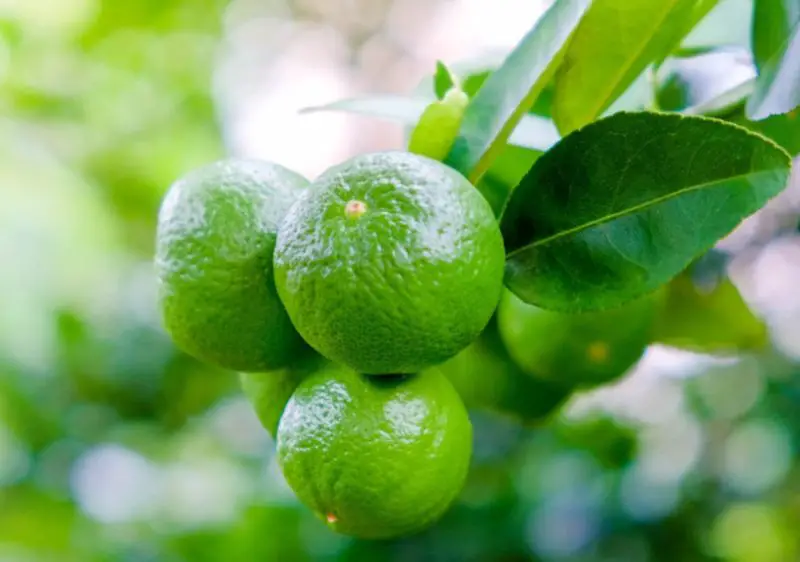Embarking on growing Mexican lime trees reveals a world of excitement and natural beauty. Knowledge is key to nurturing these trees to their fullest potential in the realm of citrus cultivation.
In this article, we guide you through growing and caring for these vibrant citrus gems, providing insights and practical advice for ensuring your Mexican lime tree thrives under your attentive care.
From selecting the ideal specimen to pest management, let’s uncover the secrets to a successful citrus harvest.
About Mexican Lime Tree

The Mexican lime tree (Citrus aurantifolia), commonly referred to as key lime, bartender’s lime, or West Indian lime, is a jewel among citrus trees. With its moderate stature, this evergreen tree fits perfectly into various landscapes, thriving vigorously once its roots are settled into the ground. Its growth can reach impressive heights of 6 1/2 to 13 feet (approximately 2 to 4 meters), making it an ideal size for both spacious and compact gardens.
Adorned with fragrant flowers that bloom amidst deep green, glossy leaves, the Mexican key lime tree is as aesthetically pleasing as it is practical. The fruits it bears are small, about the size of a golf ball, with a distinctive yellow-green hue that signals their ripeness. These limes are not just any fruit; they carry a bold, tangy flavor highly coveted by bartenders and pie bakers worldwide, making them the preferred choice for culinary and beverage creations alike.
Cultivating Mexican key limes can be a rewarding endeavor, as they are not particularly demanding in terms of care. They thrive in well-draining soil, require ample sunlight, and need regular watering to produce their prized fruits. With basic maintenance and protection from extreme cold, these trees can be a bountiful source of the vibrant, flavorful limes that are essential ingredients in many beloved recipes and drinks.
Mexican Lime Tree Growing Guide
Cultivating Mexican lime trees is a rewarding endeavor that begins with selecting a robust specimen. The quest for the perfect tree necessitates a discerning eye, particularly for the foliage, which should be devoid of any holes or ragged edges indicative of insect damage. A thorough inspection involves examining the underside of the leaves for pests and tilting the pot to inspect the drainage holes for roots. Trees with visible roots protruding from the pot are likely pot-bound, having spent considerable time confined, and should be avoided. Given the investment Mexican key lime trees require, it’s imperative to choose wisely.
These trees thrive in the warmth, suitable for the U.S. Department of Agriculture zones 10 and 11, as they are particularly sensitive to cold. For Californians, an ideal planting spot would be a protected area, preferably the south side of a house, to shield the tree from less favorable conditions. A location basking in at least 10 hours of full sunlight daily is essential for their growth.
The adaptability of Mexican key lime trees to various soil types is notable, provided the soil is well-draining and has a pH level ranging from 6.1 to 7.8. Preparation for planting involves amending a 4-foot diameter circle of soil with 4 to 5 inches of organic compost, integrating it deeply into the soil to a depth of 36 inches. After leveling the soil with a rake, allowing it a week to settle is crucial before proceeding to plant.
The planting process requires a hole twice as wide as the root ball and of equal depth. Careful removal of the container followed by an inspection of the root ball for any visible roots is necessary. Should any be found, they must be gently teased away from the root ball to prevent future growth issues, such as the roots strangling the tree. The root ball should be positioned centrally in the hole, slightly elevated above the surrounding soil level, to ensure optimal growth conditions. Backfilling the hole with soil and firming it around the root ball eliminates air pockets, securing the tree in its new home. This meticulous approach lays the foundation for a thriving Mexican key lime tree, promising the delightful bounty of its tangy fruits.
Mexican Lime Tree Care Guide
The meticulous care of Mexican key lime trees is pivotal to their health and productivity, ensuring a bountiful harvest of the tangy fruits they bear. A cornerstone of their care regimen involves watering the trees thoroughly once a week, a task that becomes even more crucial during hot and dry periods, possibly necessitating a more frequent watering schedule. Watering should be deep and slow, allowing moisture to permeate deeply into the soil, ensuring the roots are adequately hydrated.
To aid in moisture retention and suppress weed growth, a 2- to 4-inch layer of mulch spread over the soil around the tree is recommended. However, caution is advised to maintain a gap of at least 2 inches between the mulch and the tree bark to avert any potential disease risks.
Fertilization plays a critical role in the vitality of Mexican key lime trees, with a preference for slow-release fertilizers that are rich in nitrogen, denoted by an NPK ratio of 2-1-1. This nourishment should be supplemented with trace minerals such as iron, zinc, and manganese to fulfill the tree’s nutritional requirements fully. Yellowing leaves can signal a need for increased fertilization or an issue with drainage, indicating areas that may need attention to prevent adverse effects on the tree’s health.
While Mexican key lime trees are generally resilient to pests, they are not immune to disease and fungal problems. Snow scale can become an issue during prolonged drought conditions, particularly noted on the island of Niue. Other potential threats include withertip or lime anthracnose, Fusarium oxysporum, Elsinoe fawcetti (causing scab), algal disease, collar rot, and Sphaeropsis tumefaciens. Vigilance in monitoring for these diseases and timely intervention can help maintain the health and productivity of the Mexican key lime tree, ensuring it remains a vibrant and fruitful component of the garden.
People Who Read This Also Read:






